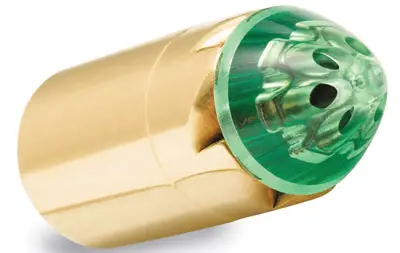|
Remington Premier AccuTip Saboted Slug Ammunition  Remington Premier AccuTip Bonded Sabot Slug Ammunition is quite a mouthful, so I'll just refer to them as Remington AccuTips. They are offered in 2-3/4 inch and 3 inch rounds, both in 20 gauge and 12 gauge, for slug guns with rifled barrels. Right now, the 20 gauge is the preferred shotgun slug platform for deer hunting, as the external ballistics are essentially the same. Some of us have a rough time understanding that just because a rifle (or rifled barrel shotgun) kicks us harder, it doesn't mean that it is going to kick a game animal harder, or make him deader better. Nothing beats shot placement and the 20 gauge is intrinsically a more accurate platform, as has been repeatedly shown. Lower recoil and more shooting comfort invariably promotes accuracy. Among the key features published by Remington are: ·
Power Port™ Tip
delivers dramatically superior accuracy ·
Spiral nose cuts and
proprietary bonding technology control expansion at all ranges from
5 to 200 yards ·
Over 95% weight
retention – weighs more after impact than all the others start with! ·
Slug jacket made from
high-strength cartridge brass ·
Designed for use in
fully-rifled barrels only We've learned a lot about sabots over the years, primarily from modern muzzleloaders. The thinner the sabot, the better. The larger the bullet diameter, the better, for a given caliber. A thinner sabot means less propensity for the bullet to cant or cock. A larger diameter bullet means more contact at the base, the area of a circle, which means less sabot stress for a given projectile weight with a larger diameter bullet. This is why the .44 caliber (.429 inch) pistol bullets often fare poorly in .50 caliber muzzleloaders compared to their .451 and .458 counterparts. Remington took advantage of this knowledge when designing the Accutips, as they use larger diameter bullets than most. One accuracy theory is that a 3 inch slug load in a 3 inch chamber is more accurate than a 2-3/4 inch shell in a 3 inch chamber. The basis for this is the 3 inch shell has a shorter jump to the forcing cone. In practice, this isn't true. Both 2-3/4 in. and 3 inch shotshell hulls are approximate unfolded lengths and a quick visual look at both cartridges quickly shows that the respective bullets are nowhere near the forcing cone and the difference in jump is trivial. While one may well group better in an individual gun, it isn't bullet jump based. In 20 gauge, the PRA20 is the 1850 fps 2-3/4 inch shell, the PRA20M is the 1900 fps three inch shell. Your rifled slug gun won't get near these velocities, nor will your rifled slug gun achieve any manufacturer's published velocities. The reason is, the standard test barrels for 20 gauge are 30 inches long, a barrel length no one I know wants in a slug gun and no manufacturer offers. With the Savage 220's 22 inch barrel for example, you'll be getting 1725 fps or so. Sighted in two inches high at 80 yards, the Remington Accutips net you about a 160 yard maximum point blank range (+/- 3"). You'll naturally need to confirm the trajectory in your rifle with your scope, but that's as good an approximation as I can give you. Since their release, the Remington Accutips have gained a superb reputation for accuracy. So much so that Remington Accutips loads are the only ammunition currently in production that Savage Arms recommends for the Model 220. Despite the windy range conditions (and being underdressed, courtesy of my own stupidity), I did a little comparison of the Accutips at 93 yards. Whether 2-3/4 inch or three inch, all shots taken would have been kill shot in the heart/lung area of a deer. In this brief comparison, the 2-3/4 inch Accutips outshot the three inch loads, although this could be attributed to barrel heating, something to consider whenever a sabot is used. As of this writing, I believe the Remington Accutips are, generally, the most accurate 20 gauge saboted slug rounds you can buy. It should be anybody's first choice to try in their 20 gauge rifled slug gun. This is doubtless a superb product from Remington. |